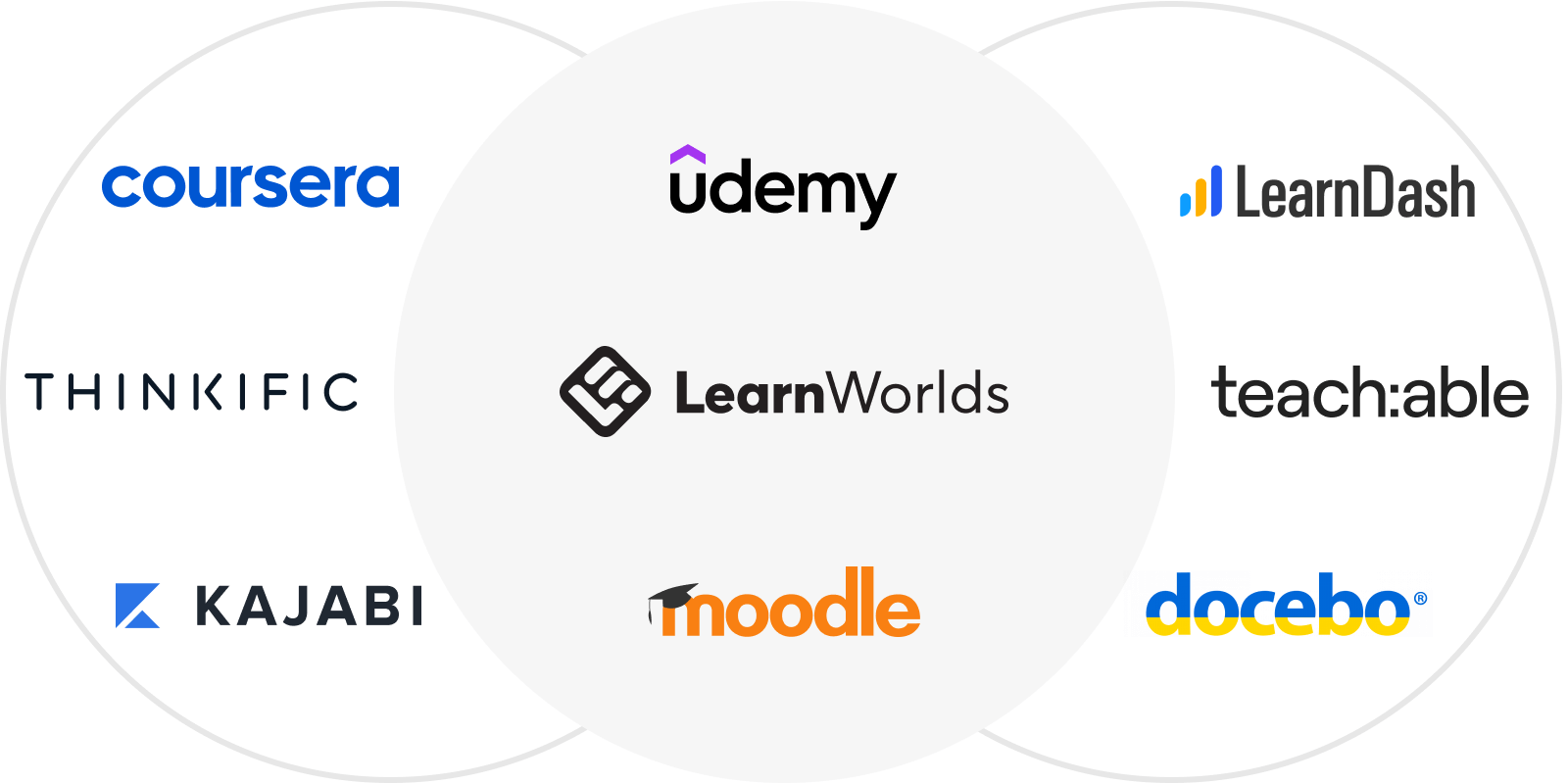Online learning platforms have changed how we access education. They offer flexibility and convenience, making learning easier for everyone.
In today’s digital age, online learning platforms are more popular than ever. They allow you to learn from anywhere, at any time. With a wide range of courses available, you can find something that matches your interests or career goals.
These platforms often include interactive content, such as videos and quizzes, to make learning engaging. Many also offer certificates upon completion, adding value to your resume. Whether you want to pick up a new hobby or gain professional skills, online learning platforms provide the tools you need. Their user-friendly interfaces and diverse course offerings make them a great resource for lifelong learning.

Credit: www.learnworlds.com
Rise Of Online Learning
Online learning platforms have transformed education. These platforms offer flexibility and access to knowledge. They serve millions worldwide, making education more accessible.
Historical Context
Online learning began in the late 20th century. Early adopters used basic websites and email. Over time, technology improved. This led to more interactive and user-friendly platforms.
In the early 2000s, platforms like Moodle and Blackboard emerged. They provided structured online courses. These platforms included features like forums, quizzes, and assignments.
The introduction of high-speed internet was a major milestone. It allowed for video lectures and real-time interaction. This significantly enhanced the online learning experience.
Growth Statistics
The growth of online learning is impressive. Here are some key statistics:
- In 2019, the global e-learning market was valued at $200 billion.
- By 2026, it is expected to reach $375 billion.
- Over 6 million students in the U.S. are enrolled in online courses.
- 70% of students say online learning is as good or better than traditional learning.
These numbers highlight the rapid adoption of online learning. They also show the growing acceptance and trust in these platforms.
Key Features
Online learning platforms have transformed the way we educate ourselves. They offer numerous features that enhance the learning experience. In this section, we will explore two key features: Interactive Content and Flexible Scheduling.
Interactive Content
Interactive content plays a crucial role in online learning. It engages students and helps them understand complex concepts. This content includes:
- Quizzes: Short tests that reinforce learning.
- Videos: Visual explanations of topics.
- Simulations: Hands-on practice in a virtual environment.
- Discussions: Forums where students can ask questions and share ideas.
Interactive content keeps students motivated. It makes learning enjoyable and effective.
Flexible Scheduling
Flexible scheduling is another significant feature of online learning platforms. It allows students to learn at their own pace. This flexibility is especially beneficial for:
- Working professionals: They can balance work and study.
- Parents: They can manage their family responsibilities.
- Students in different time zones: They can access courses anytime.
With flexible scheduling, education becomes accessible to everyone. It removes the barriers of time and location.
Online learning platforms thus provide a personalized learning experience. Interactive content and flexible scheduling are just two of the many features they offer.
Major Platforms
Online learning platforms have transformed education. They provide access to countless courses. You can learn almost anything from the comfort of your home. Some major platforms stand out due to their popularity and quality.
Coursera
Coursera is a leading online learning platform. It partners with top universities and organizations. The platform offers a wide range of courses in various fields.
- High-quality courses from renowned institutions
- Option to earn certificates and degrees
- Flexible schedules for self-paced learning
Courses are often free to audit. You pay for certificates. Coursera offers specializations and professional certificates. These can boost your career prospects.
Udemy
Udemy is another popular online learning platform. It offers a vast array of courses. These courses cover a wide range of subjects.
- Affordable courses
- Lifetime access to course materials
- Courses taught by industry experts
Udemy often has sales and discounts. You can find courses at very low prices. The platform is great for learning new skills quickly.

Credit: www.gumlet.com
Benefits For Students
Online learning platforms have transformed education, offering numerous benefits for students. These platforms provide unique advantages that cater to the diverse needs of learners. Let’s explore some of the key benefits for students.
Accessibility
Online learning platforms offer unparalleled accessibility. Students can access courses from anywhere in the world. This means no more long commutes or geographical barriers. Learners with disabilities also benefit from customizable settings and resources. For instance, they can adjust font sizes or use screen readers.
Additionally, these platforms provide flexible schedules. Students can study at their own pace, fitting learning around their personal and professional lives. This flexibility is particularly beneficial for those with busy schedules.
Cost-effectiveness
Online learning platforms are often more cost-effective than traditional education. Students save on commuting and accommodation costs. Many platforms also offer free or low-cost courses. This makes education more accessible to a wider audience.
Furthermore, online courses often provide reusable resources. Students can revisit lectures and materials as needed. This ensures they get the most value for their money.
| Benefit | Description |
|---|---|
| Accessibility | Study from anywhere, at any time, with flexible schedules. |
| Cost-Effectiveness | Save on commuting, accommodation, and get access to affordable courses. |
Impact On Traditional Education
Online learning platforms have significantly influenced traditional education. They have introduced new ways of learning and teaching that were not possible before. These platforms provide flexibility, accessibility, and a wealth of resources. Traditional education systems are now integrating these tools to enhance their teaching methods.
Blended Learning
Blended learning combines online educational materials and traditional classroom methods. This approach allows students to benefit from the best of both worlds. Students can access online resources at any time, which complements their in-class learning.
A typical blended learning model includes:
- In-person classroom sessions
- Online video lectures
- Interactive assignments
- Online discussion forums
This model promotes a more engaging and personalized learning experience. Students can learn at their own pace and revisit materials as needed. Teachers can track student progress through online assessments.
Challenges Faced
Despite the benefits, online learning platforms present several challenges. First, not all students have access to reliable internet or devices. This can create a digital divide between students who have resources and those who do not.
Another challenge is maintaining student engagement. In a traditional classroom, teachers can interact directly with students. Online platforms lack this face-to-face interaction, making it harder to keep students motivated.
Technical issues can also disrupt the learning process. Connectivity problems or software glitches can hinder the smooth delivery of content. Additionally, teachers may need training to effectively use these new tools.
Here is a summary of the challenges:
| Challenge | Description |
|---|---|
| Access to technology | Not all students have necessary devices or internet access |
| Student engagement | Harder to maintain motivation without face-to-face interaction |
| Technical issues | Connectivity problems or software glitches can disrupt learning |
| Teacher training | Teachers need training to effectively use online tools |
These challenges need to be addressed to fully realize the potential of online learning platforms. Solutions may include providing resources to underserved students, developing engaging content, and offering technical support and training.
Technological Innovations
Technological innovations are transforming the world of online learning. These advancements make learning more efficient and personalized. Let’s explore some of the most impactful innovations in this field.
Ai And Machine Learning
AI and Machine Learning are reshaping how we learn online. These technologies help create personalized learning experiences. They analyze a student’s performance and suggest improvements.
Benefits of AI and Machine Learning:
- Personalized learning paths
- Real-time feedback
- Automated grading
- Predictive analytics
AI can recommend resources that match a student’s learning style. Machine learning algorithms detect patterns in student behavior. This helps improve course content and teaching methods.
Virtual Reality
Virtual Reality (VR) brings a new dimension to online learning. It provides immersive experiences that traditional methods can’t match. VR makes learning interactive and engaging.
Uses of VR in Online Learning:
- Virtual classrooms
- Simulated environments
- Interactive tutorials
- Hands-on practice
VR allows students to explore complex subjects visually. They can practice skills in a safe, virtual environment. This boosts their understanding and retention.
Both AI and VR are vital for the future of online learning. They provide unique ways to engage students and improve outcomes. Embracing these technologies can lead to better learning experiences.
Future Trends
The landscape of online learning platforms continues to evolve. Technology is pushing boundaries, and the future looks promising. Emerging trends are shaping how we learn and interact online. Here, we discuss two key trends: personalized learning and global reach.
Personalized Learning
Personalized learning tailors education to individual needs. Online platforms use data to understand each learner’s style and pace.
Key aspects of personalized learning include:
- Adaptive Learning: Systems adjust content based on learner performance.
- Custom Learning Paths: Courses match individual goals and skills.
- Real-Time Feedback: Immediate insights help improve learning outcomes.
Personalized learning makes education more effective and engaging. It caters to various learning preferences, ensuring everyone benefits.
Global Reach
Online learning platforms break geographical barriers. They offer education to a global audience.
Some benefits of global reach include:
| Benefit | Description |
|---|---|
| Access to Expertise: | Learn from experts worldwide, regardless of location. |
| Diverse Perspectives: | Interact with learners from different cultures and backgrounds. |
| Language Options: | Courses are available in multiple languages, making learning more inclusive. |
Global reach democratizes education. It allows learners to access high-quality education anywhere in the world.
Challenges And Solutions
Online learning platforms have gained immense popularity. Yet, they face several challenges. This section explores the key obstacles and provides practical solutions.
Digital Divide
The digital divide remains a significant barrier. Many students lack access to reliable internet. This makes it hard for them to participate in online classes.
Solution: Providing affordable internet and devices is crucial. Governments and organizations can offer subsidies or donations. Schools can also create offline resources for students without internet.
| Challenge | Solution |
|---|---|
| Lack of Internet Access | Provide affordable internet and devices |
| Limited Device Availability | Offer subsidies or donations |
Quality Assurance
Ensuring the quality of online education is another challenge. Many platforms offer a wide range of courses. But not all of them meet high educational standards.
Solution: Implement strict quality control measures. Platforms should have accreditation processes. Regular reviews and updates can ensure content remains relevant and effective.
- Implement strict quality control
- Ensure accreditation processes
- Regularly review and update content
Online learning platforms have a lot to offer. Addressing these challenges can help maximize their potential.

Credit: www.linkedin.com
Frequently Asked Questions
What Are Online Learning Platforms?
Online learning platforms are websites or apps for education. They offer courses, tutorials, and learning materials.
How Do Online Learning Platforms Work?
They provide courses that you can access online. You can learn at your own pace and place.
Are Online Learning Platforms Effective?
Yes, they are effective. They offer flexible schedules and access to a wide range of courses.
Can I Get A Certificate From Online Learning Platforms?
Yes, many platforms provide certificates. These can be used to show your skills and knowledge.
Do Online Learning Platforms Cost Money?
Some are free, while others require payment. Costs vary depending on the course and platform.
What Are The Benefits Of Online Learning Platforms?
They offer flexibility, a variety of courses, and the ability to learn at your own speed.
Which Online Learning Platform Is The Best?
It depends on your needs. Popular ones include Coursera, Udemy, and Khan Academy. Each has unique features.
Conclusion
Online learning platforms provide flexible and accessible education for everyone. They offer a variety of courses suited for different interests and needs. Learners can progress at their own pace and schedule. These platforms also help save time and money compared to traditional classes.
With online learning, anyone can gain new skills and knowledge from home. So, explore these platforms and start your educational journey today. Education has never been this convenient and affordable. Embrace the future of learning and grow your skills online.


